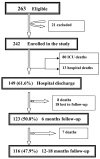Quality of life outcome of critical care survivors eighteen months after discharge from intensive care
- PMID: 18074416
- PMCID: PMC2213799
- DOI: 10.3325/cmj.2007.6.814
Quality of life outcome of critical care survivors eighteen months after discharge from intensive care
Abstract
Aim: To assess the changes in health-related quality of life in patients discharged from the intensive care unit (ICU).
Methods: At the General University ICU, Trauma Hospital in Athens, 242 patients were enrolled prospectively over a study period of 18 months. Out of these, 116 participants (47.9%) completed all survey components at 6, 12, and 18 months. We used Quality of Life-Spanish (QOL-SP) to assess the health-related quality of life. Patients or their relatives were interviewed on ICU admission and at 6, 12, and 18 months after discharge from the ICU.
Results: Mean quality of life score of the patients increased from 2.9+/-4.8 (out of maximum 25 points) on ICU admission to 7.0+/-7.2 points at 6 months after discharge, and then decreased to 5.6+/-6.9 points at 18 months (P<0.001; Friedman Test). Multilinear regression analysis showed that the variables which had the strongest association with the quality of life on admission were age (P=0.002) and male sex (P=0.001), whereas age (P<0.001), length of ICU stay (P<0.001), and male sex (P=0.002) had the strongest association 18 months after discharge from the ICU. Survival rate was 66.9% at discharge from ICU and 61.6% at hospital discharge. There were 33% deaths in the ICU, 5.3% in the hospital, and 6.2% after ICU discharge. There were 7.4% patients lost to follow-up.
Conclusions: After discharge from the ICU, patients' quality of life was poor and showed an improvement at 18 months after discharge, but was still worse than on admission. Age, ICU length of stay, and male sex were the factors that had the strongest impact on the quality of life on admission and at 18 months after discharge from the ICU.
Figures


Similar articles
-
Survival, morbidity, and quality of life after discharge from intensive care.Crit Care Med. 2000 Jul;28(7):2293-9. doi: 10.1097/00003246-200007000-00018. Crit Care Med. 2000. PMID: 10921555
-
Functional Status and Quality of Life in Elderly Intensive Care Unit Survivors.J Am Geriatr Soc. 2016 Mar;64(3):536-42. doi: 10.1111/jgs.14031. J Am Geriatr Soc. 2016. PMID: 27000326
-
Quality of life before intensive care unit admission and its influence on resource utilization and mortality rate.Crit Care Med. 2001 Sep;29(9):1701-9. doi: 10.1097/00003246-200109000-00008. Crit Care Med. 2001. PMID: 11546968
-
How Does Health-Related Quality of Life Change Over Time in Cancer Survivors Following an Admission to the Intensive Care Unit?: An Integrative Review.Cancer Nurs. 2024 Mar-Apr 01;47(2):100-111. doi: 10.1097/NCC.0000000000001157. Epub 2022 Dec 11. Cancer Nurs. 2024. PMID: 36066345 Review.
-
Outcome Measurement in ICU Survivorship Research From 1970 to 2013: A Scoping Review of 425 Publications.Crit Care Med. 2016 Jul;44(7):1267-77. doi: 10.1097/CCM.0000000000001651. Crit Care Med. 2016. PMID: 26992067 Free PMC article.
Cited by
-
Changes in health-related quality of life after discharge from an intensive care unit: a systematic review.Anaesthesia. 2019 Jan;74(1):100-108. doi: 10.1111/anae.14444. Epub 2018 Oct 6. Anaesthesia. 2019. PMID: 30291744 Free PMC article.
-
The health status of Q-fever patients after long-term follow-up.BMC Infect Dis. 2011 Apr 18;11:97. doi: 10.1186/1471-2334-11-97. BMC Infect Dis. 2011. PMID: 21501483 Free PMC article.
-
Demographic, psychosocial, and medical correlates ofpsychological morbidity after intensive care unit stay.Health Psychol Rep. 2022 Feb 22;10(3):191-202. doi: 10.5114/hpr.2022.113515. eCollection 2022. Health Psychol Rep. 2022. PMID: 38084273 Free PMC article.
-
Functional and psychological features immediately after discharge from an intensive care unit: prospective cohort study.Rev Bras Ter Intensiva. 2013 Jul-Sep;25(3):218-24. doi: 10.5935/0103-507X.20130038. Rev Bras Ter Intensiva. 2013. PMID: 24213085 Free PMC article.
-
Increased risk of death and readmission after hospital discharge of critically ill patients in a developing country: a retrospective multicenter cohort study.Intensive Care Med. 2018 Jul;44(7):1090-1096. doi: 10.1007/s00134-018-5252-3. Epub 2018 Jul 12. Intensive Care Med. 2018. PMID: 30003303
References
-
- Heyland DK, Konopad E, Noseworthy TW, Johnston R, Gafni A. Is it 'worthwhile' to continue treating patients with a prolonged stay (>14 days) in the ICU? An economic evaluation. Chest. 1998;114:192–8. - PubMed
Publication types
MeSH terms
LinkOut - more resources
Full Text Sources

